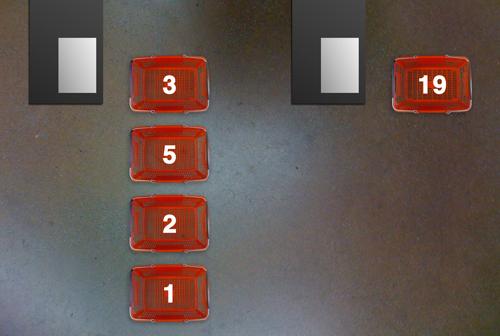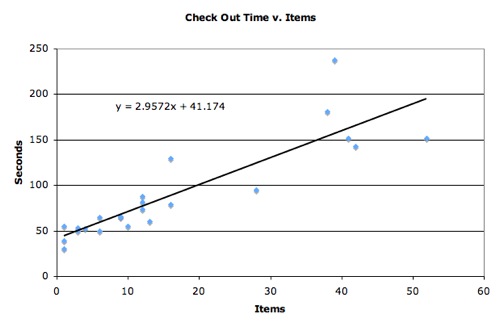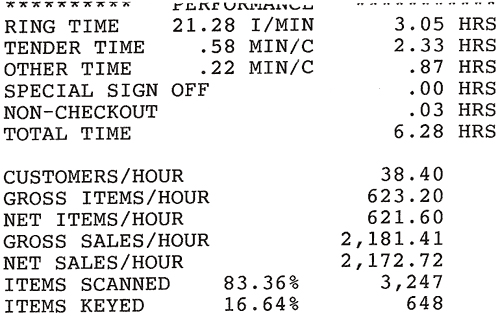Which line in the store is faster?
Each of us spends hours of life standing in lines of supermarkets. Surely you noticed that neighboring lines are moving at different speeds. The speed of the queue depends on the quantity of goods in the basket of each customer.

Dan Meyer from Stanford University for months measured the speed of cash registers, entered all the data in a table and derived the following formula:
This is the formula for the dependence of service speed in seconds (y) on the quantity of goods (x).

Of course, the sample is small. Apparently, Dan only measured his own indicators.
But then he dared to ask the store manager to provide this information. He first refused, and then gave him a printout from a cash register scanner on the efficiency of one cashier per shift ( PDF ). The value of this information is difficult to overestimate.

From the printout (this is a grocery supermarket) we see that the goods at the checkout are scanned at a speed of 21.28 units per minute, that is, about 2.8 seconds per unit of goods.
Another important parameter is the second line. This is the “waiting time” between product scanning sessions. At this time, the calculation, packaging, other actions. So, on average, the cashier spends 35 seconds (0.58 minutes) per customer.
This is all you need to know to calculate the speed of the queues in the supermarket. Each person - 35 seconds, each unit of goods in the basket - plus 2.8 seconds. For example, one person with 14 units of goods (35 + 2.8 * 14) is equal to two people with one product for each (35 * 2 + 2.8 * 2).
As you can see, this is close to the parameters in the Den formula (2.95 seconds per product, 41 seconds per customer).
Of course, in different stores the formula can change. For example, in some stores the cashier does not help to pack the goods, so the service speed (35 seconds) is significantly increased. It is best to get data on the effectiveness of service from the supermarket where you personally buy products.
Obviously, the scanning speed is approximately the same for everyone - from 2.8 to 3 seconds. So it remains to measure the average interval between scan sessions. And then, walking along the ticket office with a trained eye, you will quickly calculate the speed of each queue in seconds.

Dan Meyer from Stanford University for months measured the speed of cash registers, entered all the data in a table and derived the following formula:
y = 2.9572x + 41.174
This is the formula for the dependence of service speed in seconds (y) on the quantity of goods (x).

Of course, the sample is small. Apparently, Dan only measured his own indicators.
But then he dared to ask the store manager to provide this information. He first refused, and then gave him a printout from a cash register scanner on the efficiency of one cashier per shift ( PDF ). The value of this information is difficult to overestimate.

From the printout (this is a grocery supermarket) we see that the goods at the checkout are scanned at a speed of 21.28 units per minute, that is, about 2.8 seconds per unit of goods.
Another important parameter is the second line. This is the “waiting time” between product scanning sessions. At this time, the calculation, packaging, other actions. So, on average, the cashier spends 35 seconds (0.58 minutes) per customer.
This is all you need to know to calculate the speed of the queues in the supermarket. Each person - 35 seconds, each unit of goods in the basket - plus 2.8 seconds. For example, one person with 14 units of goods (35 + 2.8 * 14) is equal to two people with one product for each (35 * 2 + 2.8 * 2).
As you can see, this is close to the parameters in the Den formula (2.95 seconds per product, 41 seconds per customer).
Of course, in different stores the formula can change. For example, in some stores the cashier does not help to pack the goods, so the service speed (35 seconds) is significantly increased. It is best to get data on the effectiveness of service from the supermarket where you personally buy products.
Obviously, the scanning speed is approximately the same for everyone - from 2.8 to 3 seconds. So it remains to measure the average interval between scan sessions. And then, walking along the ticket office with a trained eye, you will quickly calculate the speed of each queue in seconds.
